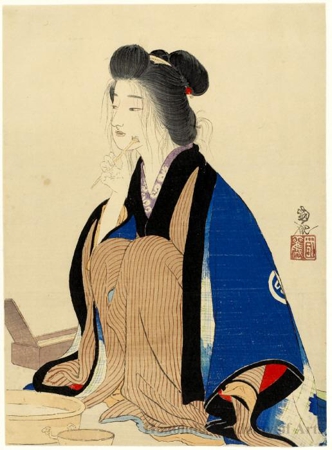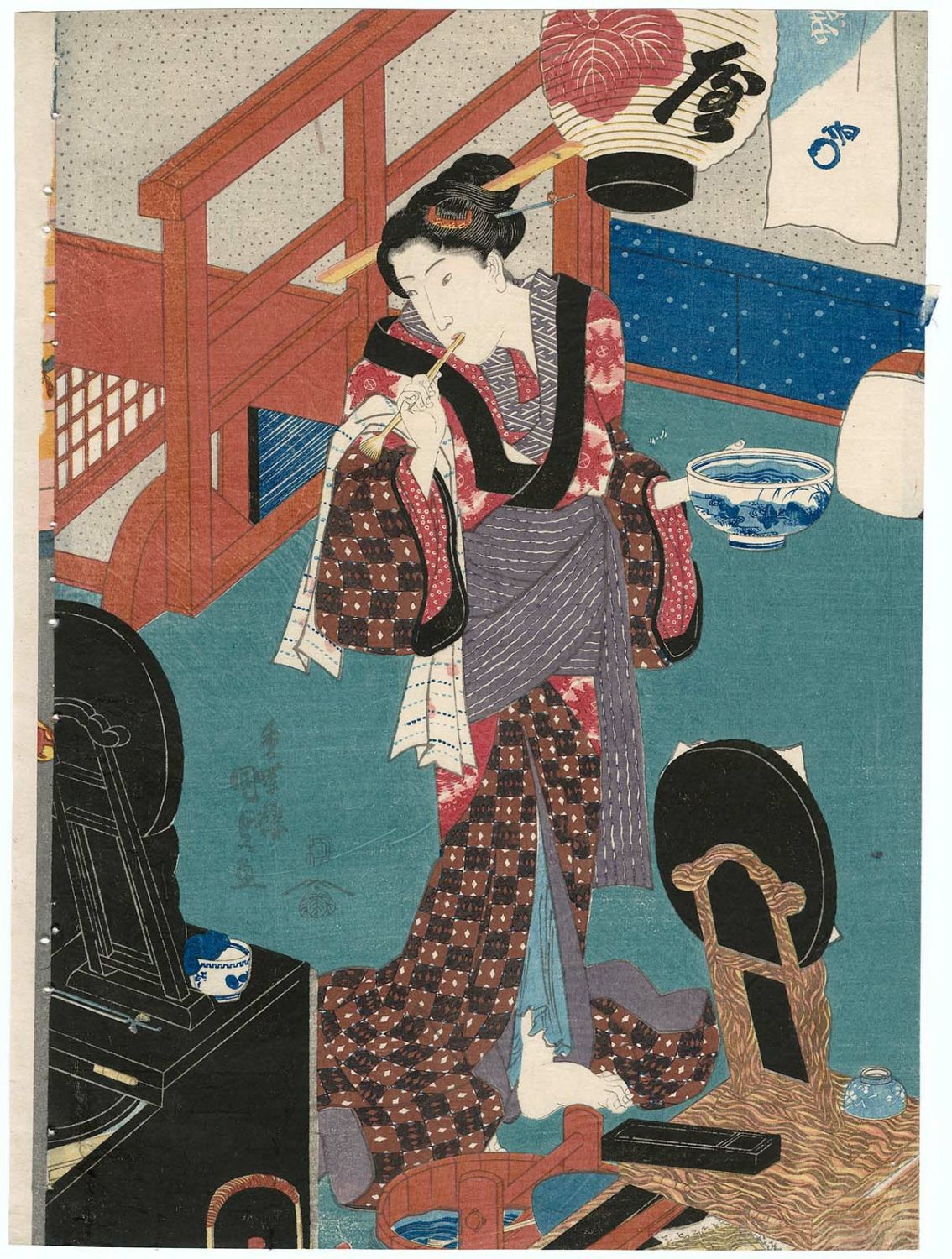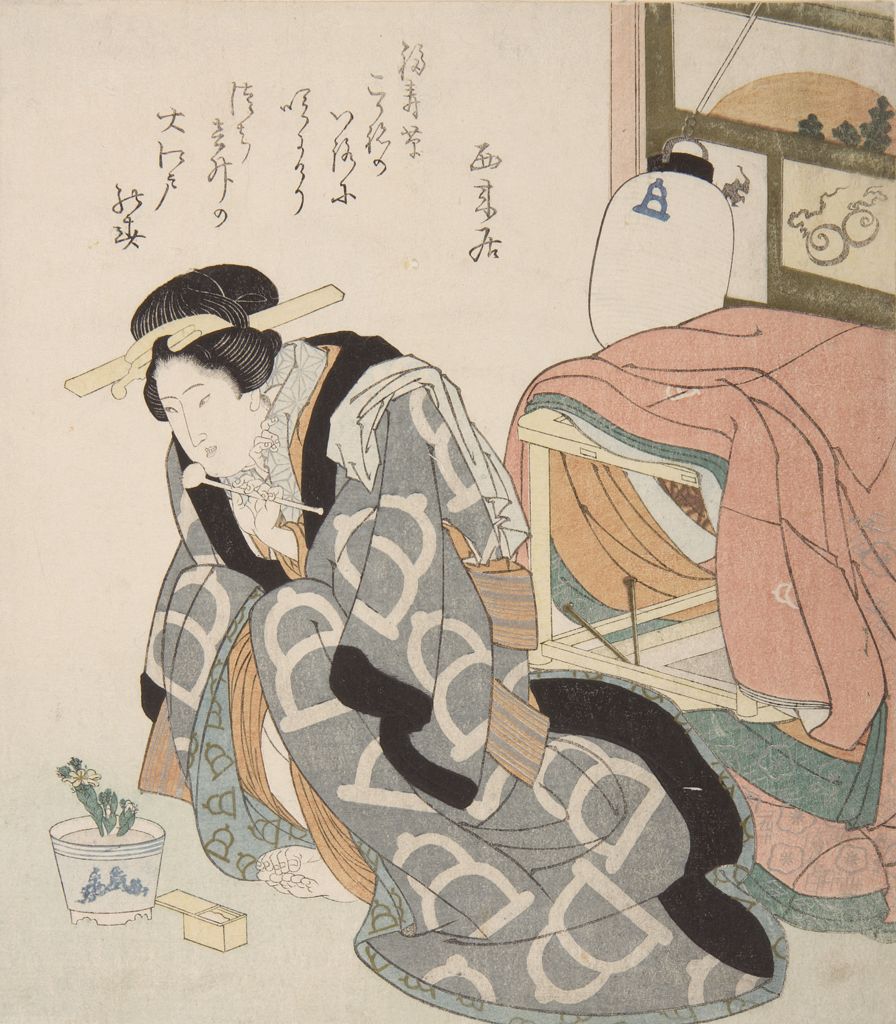-
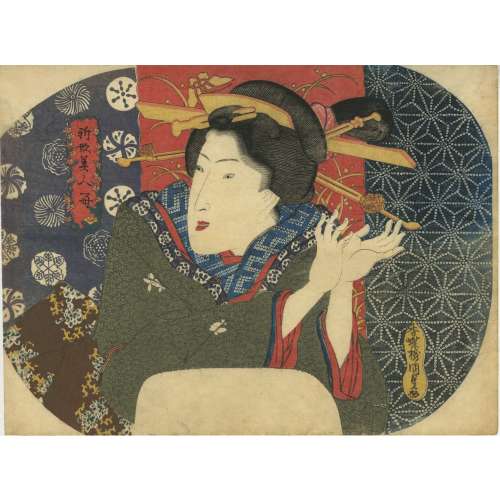 NEWHalf-length portrait of a beautiful young woman wearing a chrysanthemum-patterned green kimono, face directed 3/4 to the right, holding her hands together and fingers spread, arranging the hairpins in her elaborate hairdo; garments of different colours and pattern designs on the background. Series: The taste of the new type of woman (Shingata bijin konomi) [新形美人好]. Artist: Utagawa Kunisada [歌川 国貞], a.k.a. Utagawa Toyokuni III [三代 歌川 豊国] (Japanese, 1786 – 1865). Signed: Kōchōrō Kunisada ga [香朝楼國貞画] in a yellow double-gourd cartouche. No publisher seal. No censor/date seal. Media: Untrimmed fan print (Aiban yoko-e uchiwa-e), 228 x 305 mm.
NEWHalf-length portrait of a beautiful young woman wearing a chrysanthemum-patterned green kimono, face directed 3/4 to the right, holding her hands together and fingers spread, arranging the hairpins in her elaborate hairdo; garments of different colours and pattern designs on the background. Series: The taste of the new type of woman (Shingata bijin konomi) [新形美人好]. Artist: Utagawa Kunisada [歌川 国貞], a.k.a. Utagawa Toyokuni III [三代 歌川 豊国] (Japanese, 1786 – 1865). Signed: Kōchōrō Kunisada ga [香朝楼國貞画] in a yellow double-gourd cartouche. No publisher seal. No censor/date seal. Media: Untrimmed fan print (Aiban yoko-e uchiwa-e), 228 x 305 mm. -
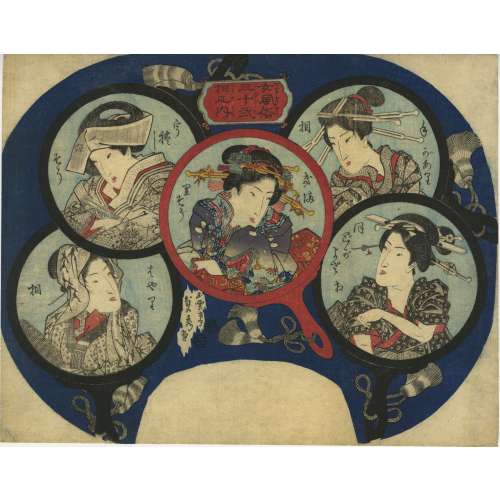 NEWArtist: Utagawa Sadahide [歌川貞秀] (Japanese, 1807 – 1879). Signed: Gountei Sadahide ga [五雲亭貞秀画] (Picture by Gountei Sadahide). Publisher: Ibaya Senzaburō [伊場屋仙三郎] (Japanese, c. 1815 – 1869); seal 三 in a circle Published: 1830s – no date seal, no censor seal (privately printed?) Media: Fan print (uchiwa-e, 団扇絵), 235 x 298 mm Inscriptions in kanji with furigana readings: Top right: "The Handy Type" (手があり相, te ga ari sō) – A composed woman adjusting her clothing. Bottom right: "Images of Manners" (風ぞくが, fūzokuga) – Possibly referring to depictions of etiquette or courtesan behaviour. The additional phrase 宵闇 (yoyami) 相 (sō) suggests a connection to nighttime activities. Centre: "The Proper Type" (きまり相, kimari sō) – A well-dressed woman seated elegantly, signifying a composed demeanour. Top left: Unclear reading (ほう☆し そう or ☆ほし そう) – Possibly related to 奉仕 (hōshi, "service" or "devotion"), implying attentiveness or subservience. Bottom left: "The Popular Type" (はやり相, hayari sō) – A fashionable woman wearing a partially veiled head covering, reflecting contemporary trends. Thanks to Horst Graebner.
NEWArtist: Utagawa Sadahide [歌川貞秀] (Japanese, 1807 – 1879). Signed: Gountei Sadahide ga [五雲亭貞秀画] (Picture by Gountei Sadahide). Publisher: Ibaya Senzaburō [伊場屋仙三郎] (Japanese, c. 1815 – 1869); seal 三 in a circle Published: 1830s – no date seal, no censor seal (privately printed?) Media: Fan print (uchiwa-e, 団扇絵), 235 x 298 mm Inscriptions in kanji with furigana readings: Top right: "The Handy Type" (手があり相, te ga ari sō) – A composed woman adjusting her clothing. Bottom right: "Images of Manners" (風ぞくが, fūzokuga) – Possibly referring to depictions of etiquette or courtesan behaviour. The additional phrase 宵闇 (yoyami) 相 (sō) suggests a connection to nighttime activities. Centre: "The Proper Type" (きまり相, kimari sō) – A well-dressed woman seated elegantly, signifying a composed demeanour. Top left: Unclear reading (ほう☆し そう or ☆ほし そう) – Possibly related to 奉仕 (hōshi, "service" or "devotion"), implying attentiveness or subservience. Bottom left: "The Popular Type" (はやり相, hayari sō) – A fashionable woman wearing a partially veiled head covering, reflecting contemporary trends. Thanks to Horst Graebner. -
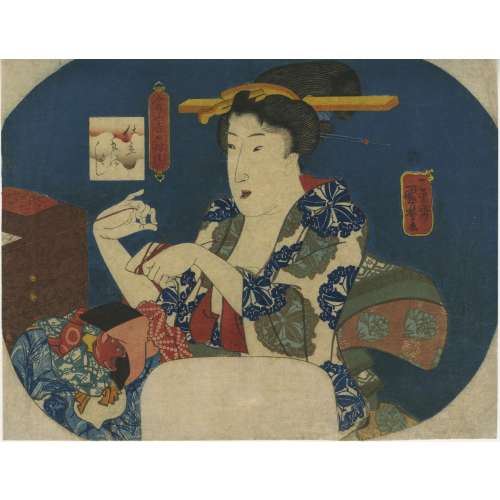 NEW
NEWA half-length portrait of a woman seated in an interior, winding red thread, dressed in a richly decorated kimono featuring intricate floral motifs in blue, green, and brown hues with a red underlayer. Her elaborately styled hair is adorned with a yellow comb and multiple hairpins. To her left is a partially visible wooden chest of drawers, to which a piece of red paper bearing calligraphy is affixed. A puppet or doll dressed in a patterned kimono with a striking red-painted face rests on her lap or a surface before her.
An uncut fan print (aiban yoko-e uchiwa-e) entitled “Good tailoring” or “Good sewing [仕立ものよし] (shitate monoyoshi)” from the series "It’s an Auspicious Day to…" [最上吉日つくし] (Saijō [no] kichijitsu tsukushi).
Artist: Utagawa Kuniyoshi [歌川 國芳] (Japanese, 1798 – 1861).
Signature: Ichiyûsai Kuniyoshi giga (一勇斎 國芳戯画, playfully drawn by Ichiyûsai Kuniyoshi).
Publisher: Enshūya Matabei [遠州屋又兵衛] (Enterprise, active c. 1768 – 1881); seal: "to" (ト) under roof (Marks 01-031 | 057a). Nanushi seal Watari (渡) for Watanabe Shōemon, VI/1842-V 1c/1846. Media: Fan print (uchiwa-e, 団扇絵), 224 x 290 mm. Reference: (1) Kuniyoshi project; (2) Tokyo Museum Digital Archive [Thanks to Horst Greabner] -
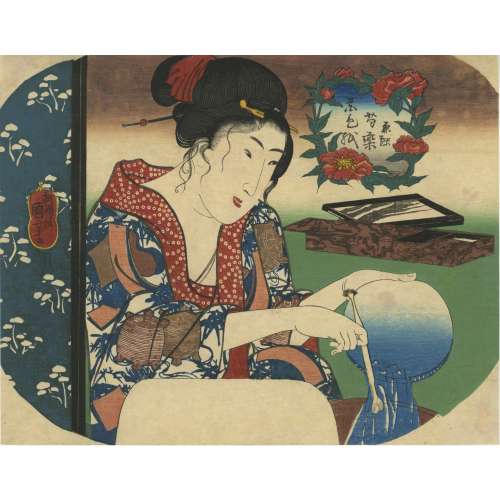 NEWPeonies (Shakuyaku) [芍薬] Series: Flower-Colored Papers (Hana Shikishi) [花色紙] Artist: Utagawa Kuniyoshi [歌川 國芳] (Japanese, 1798–1861) Signature: Chō-ō-rō Kuniyoshi ga (朝櫻楼 國芳 画) Publisher: Kojimaya Jūbei [小島屋 十兵衛] (Japanese, 1797 – 1869); seal 十, Marks 06-014 | 264a Date/Censorship Approval: Nanushi seal Yoshimura (吉村) for Yoshimura Gentarō (吉村 源太郎), VI/1843–XI/1846. Medium: Rigid fan print (Aiban Yoko-e Uchiwa-e, 合判横絵 団扇絵), 222 x 284 mm.
NEWPeonies (Shakuyaku) [芍薬] Series: Flower-Colored Papers (Hana Shikishi) [花色紙] Artist: Utagawa Kuniyoshi [歌川 國芳] (Japanese, 1798–1861) Signature: Chō-ō-rō Kuniyoshi ga (朝櫻楼 國芳 画) Publisher: Kojimaya Jūbei [小島屋 十兵衛] (Japanese, 1797 – 1869); seal 十, Marks 06-014 | 264a Date/Censorship Approval: Nanushi seal Yoshimura (吉村) for Yoshimura Gentarō (吉村 源太郎), VI/1843–XI/1846. Medium: Rigid fan print (Aiban Yoko-e Uchiwa-e, 合判横絵 団扇絵), 222 x 284 mm.Interpretation of the Inscription in the Floral Cartouche
- 花色紙 (Hana Shikishi) – "Flower-Colored Paper" or "Decorative Shikishi Paper with Floral Motifs"
- 芍薬 (Shakuyaku) – "Peony", a flower symbolizing prosperity, beauty, and romance in Japanese culture
- 団扇絵 (Uchiwa-e) – "Round Fan Illustration" or "Picture on an Uchiwa (rigid fan)"
Description & Symbolic Analysis
This print, part of the Hana Shikishi (Flower-Colored Papers) series, depicts a woman washing a basin after brushing her teeth. She is positioned behind an indigo-colored folding screen, adorned with a repeating pattern of distant pines, presented in reverse printing technique (wyabori, 捺ぼり). The screen is a visual separator, adding depth and an intimate atmosphere to the scene. The woman is portrayed in a three-quarter view, facing left, her face delicately contoured. She is dressed in a safflower-dyed kimono (furisode, 振袖) featuring an asanoha (麻の葉, hemp leaf) shibori pattern, a motif often associated with purity and protection. Over this, she wears an outer garment decorated with an indigo bamboo motif, symbolizing strength and resilience. Additionally, the garment features:- Double gourd (瓢箪, hyōtan) symbolises longevity, fertility, and good fortune.
- Strips of paper resembling “next-morning letters” (kinuginu no fumi, 衣衣の文) – These evoke romantic correspondence or the written wishes of the Tanabata festival.
- Spools or reels of thread (chikiri, 糸巻き) – A motif reminiscent of Tanabata festival themes, often linked to the celestial lovers Orihime and Hikoboshi. The phonetic pun with chigiri (契り, vow or romantic promise) reinforces themes of marriage, fate, and lifelong bonds.
Adornment & Hairstyling
Her elaborate hairstyle features a red hair tie (musubi, 結び), signifying youth and romantic allure. It is further adorned with:- Golden kogai (笄) – A decorative hairpin, often used by courtesans or high-ranking women.
- Tama kanzashi (玉簪) – A ball-tipped ornamental hairpin, reinforcing her refined status.
Objects in the Scene & Their Symbolism
The woman is holding a traditional Japanese toothbrush (fusa-yōji, ふさ楊枝) in her right hand, while pouring out water from the basin after brushing her teeth. This act symbolizes purity and preparation for intimacy. To her right, an ornate lacquered writing box (suzuribako, 硯箱) is placed near an inkstone (硯, suzuri). This object could also be interpreted as a dreamstone (梦石, mèng shí), a scholar’s object associated with nostalgia, love, or secret communication.Context in Ukiyo-e Tradition
Tooth brushing was uncommon in bijin-ga (美人画, "beautiful woman prints"). Ukiyo-e frequently depicted women engaging in personal grooming rituals, reflecting ideals of elegance and self-care in Edo-period culture.
Two additional fan prints from the Hana Shikishi series have been identified and can be found at the Kuniyoshi Project website:- Morning Glory (Asagao, 朝顔)
- Clematis (Tessen, 鉄線)
These prints, like Peonies (Shakuyaku), emphasize seasonal beauty and feminine refinement, themes central to Kuniyoshi’s bijin-ga oeuvre.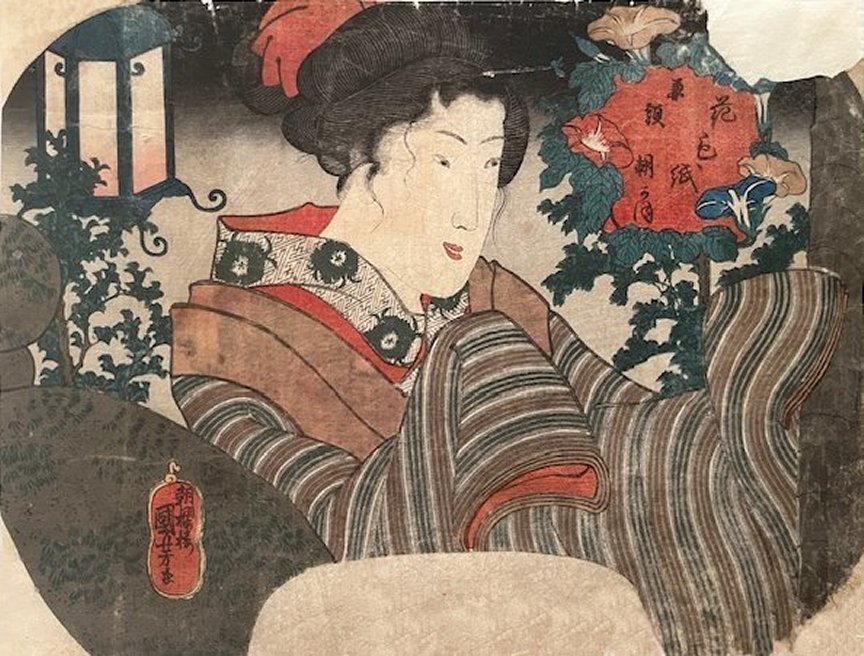
Morning Glory (Asagao, 朝顔)
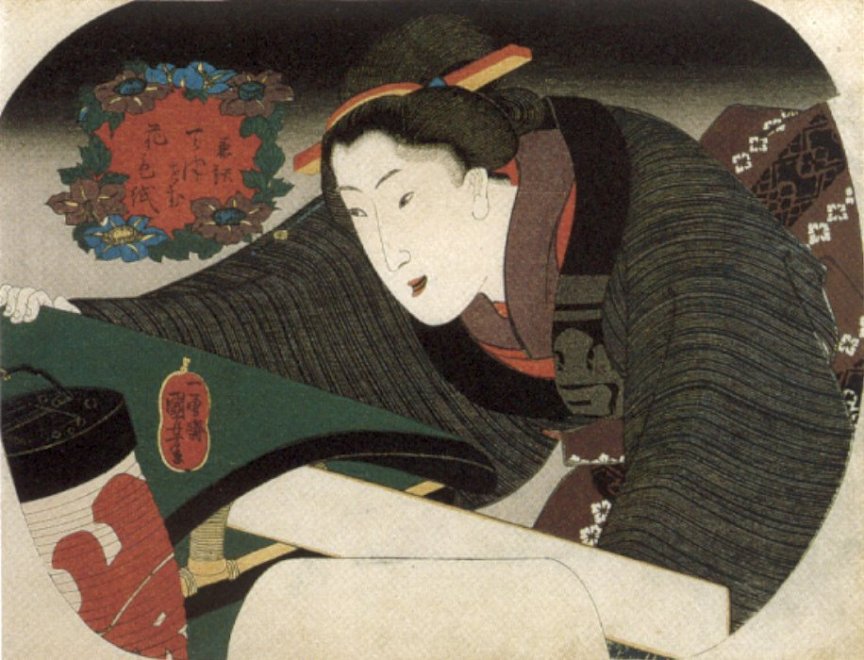
Clematis (Tessen, 鉄線)
-
 NEWArtist: Utagawa Kuniyoshi (歌川国芳) (1797–1861) Signed: 一勇斎 (Ichiyūsai) in a yellow cartouche, 國芳画 (Kuniyoshi ga) in a red cartouche Publisher: 未詳 (Yama-Ta), seal [板元, 太] – Hanmoto, Ta; Marks 19-044 | U421b Censor Seal: Aratame + Ansei 3 (3rd lunar month, 1856) Block Carver: 彫竹 (Hori Take), identified as Yokokawa Takejirō (横川竹二郎) (fl. 1845–1863) Media: Rigid fan print (Aiban Yoko-e Uchiwa-e, 合判横絵 団扇絵), 227 × 286 mm Half-length portrait of a high-ranking courtesan (oiran, 花魁) seated in a three-quarter view, holding a porcelain sake cup decorated with a blue mon of stylized oak leaves (kashiwa, 柏). She gazes downward at a partially unrolled letter resting on her lap. Her elaborate hairstyle, adorned with multiple kogai (ornamental hairpins) featuring golden floral motifs, signifies her elevated status within her profession. Her layered kimono displays a combination of red, blue, and black geometric patterns, emphasizing the luxurious textiles associated with courtesans of her rank. The stylized oak leaves on the sake cup may allude to the family mon of Onoe family of kabuki actors, evoking the overlap between theatre and the pleasure quarters. The background portrays a night scene in the Yoshiwara Pleasure District (吉原), where figures move beneath lantern-lit buildings, showing the vibrant nightlife of Edo.
NEWArtist: Utagawa Kuniyoshi (歌川国芳) (1797–1861) Signed: 一勇斎 (Ichiyūsai) in a yellow cartouche, 國芳画 (Kuniyoshi ga) in a red cartouche Publisher: 未詳 (Yama-Ta), seal [板元, 太] – Hanmoto, Ta; Marks 19-044 | U421b Censor Seal: Aratame + Ansei 3 (3rd lunar month, 1856) Block Carver: 彫竹 (Hori Take), identified as Yokokawa Takejirō (横川竹二郎) (fl. 1845–1863) Media: Rigid fan print (Aiban Yoko-e Uchiwa-e, 合判横絵 団扇絵), 227 × 286 mm Half-length portrait of a high-ranking courtesan (oiran, 花魁) seated in a three-quarter view, holding a porcelain sake cup decorated with a blue mon of stylized oak leaves (kashiwa, 柏). She gazes downward at a partially unrolled letter resting on her lap. Her elaborate hairstyle, adorned with multiple kogai (ornamental hairpins) featuring golden floral motifs, signifies her elevated status within her profession. Her layered kimono displays a combination of red, blue, and black geometric patterns, emphasizing the luxurious textiles associated with courtesans of her rank. The stylized oak leaves on the sake cup may allude to the family mon of Onoe family of kabuki actors, evoking the overlap between theatre and the pleasure quarters. The background portrays a night scene in the Yoshiwara Pleasure District (吉原), where figures move beneath lantern-lit buildings, showing the vibrant nightlife of Edo.



